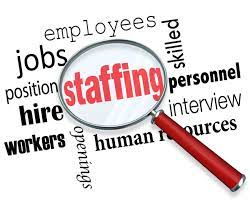What are the Functions of Staffing?
Every organization wants the right person for the job but is unsure of how to get them in time and accommodate a demand. Staffing is the process of finding the right people for the job at the right time, evaluating their performance, and developing a working relationship with them. Through staffing solutions, organizations can maintain a satisfied and productive workforce and also get several other benefits.
What are the functions of staffing?
The functions of staffing, which by itself is a function of management, are requisition, selection, training, placement, transfer, and compensation. They can be carried out by an in-house HR team or by a temp agency or staffing company.
What is the process of staffing in the management function?
Staffing is one of the five traditional functions in management. It is a management function too, as it requires managerial skills and is the most important of all the management functions, as the efficacy of every other function depends on how well staffing happens.
What is the importance of staffing functions in today’s environment?
The main importance of staffing is that it helps find people who are suitable for a particular job role, are productive enough, and who can contribute to the company’s reputation and growth. It could be for the long-term or short-term and on a full-time or temporary basis.
What Activities Are Involved in the Staffing Function of HRM?
There are several steps involved in the staffing function. Let us look at some of them now:
Requisition: In the requisition phase, the staffing solutions provider invites applications from candidates based on the completed brief that is sent by the organization requesting staffing services. The staffing provider will post the requirements on multiple portals and will also contact its pre-existing network of great talent.
Selection: The selection phase begins with the staffing solutions provider selecting the candidates through a number of rounds of screening. The rounds of screening will test for professional skills, quantitative, language, and analytical skills, as well as people and management skills, either through a written test or by means of an audio or video interview.
Orientation and placement: Once the candidates are selected, orientation begins. Orientation is essentially the process of introducing the candidates to the job role, explaining its challenges, and also testing them to see if they are a great professional and cultural fit for the role in the organization. Following this, actual placement begins, and the job role is assigned to the staff member.
Training: Training helps to put the placed candidates on track, allowing them to report to the manager, complete tasks, and maintain their productivity in a meaningful manner. It also prepares them for the workplace culture and ensures that they are not left out or left behind at any point.
Remuneration: It takes care of the monetary requirements of the staff, including how much they are paid and how often: weekly, monthly, or quarterly. This remuneration will be confirmed with the staffing provider in case the hires actually demand a little more than the set limit.
Performance evaluation: A track or record of the performance and behaviour of each employee is maintained to ensure that they are continuously assessed at regular intervals throughout their work with the organization. This helps give the organization the assurance that things are moving smoothly and that the performance and productivity of the new staff are also improving.
Promotion or transfer: In this step of the process, the staff may be promoted on the basis of performance evaluation, feedback, cultural fit, etc. within the organization to a higher and more demanding role. Alternatively, the staff member may be transferred to a different location or a different department within the organization, where he or she would find his or her skills really handy.
What are the advantages of the staffing function of management?
Staffing has several benefits, but there are four main advantages to it. They are:
Jobs for the right people:
Getting the right people for the listed jobs at the right time is a requirement not every organization can fulfil with an in-house HR team. This is why they need to talk to an HR consulting company like Alp Consulting, which can meet their requirements.
Increased productivity:
When the staffing provider makes the right decisions and is resourceful enough, then the productivity of the team goes up, and consequently, this impacts the growth of the company in a positive way.
Improved staff member satisfaction:
When the staffing provider makes all the right choices, the employees hired will be a great cultural fit too, and this will in turn lead to greater satisfaction and engagement for each staff member.
Organizational harmony:
When there are processes in place for analysing the performance of hires and understanding how they can improve and be rewarded, it brings about an understanding between hires and management, which in turn leads to organizational harmony.
Example of Staffing in Management Function
There are several examples of staffing in management. One of the best examples is a temp hire. A person is hired for a short period of time to satisfy a specific requirement, such as a project that needs attention. This period generally lasts from three to six months.
When that time is over, the staff member can be offered a permanent role if the person is a good cultural fit and his or her productivity is very good. Not only is this process of temp-to-hire much faster, but it also allows the organization to avoid having to commit to a hire and gives them the flexibility to try other options too at a later time and date.
Looking to convert a temporary hire into a full-time employee? You must encourage the temp hire to follow a dress code, learn more about the company, get trained on the job role to perform the tasks better, and be proactive at work, identifying issues before it is too late and contributing solutions that help improve the workplace.






